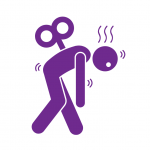Fatigue is an all-too common complaint, but have you ever stopped to consider the effect of fatigue on health and safety in your workplace?
What do you need to know about the effect of fatigue on people at work? And more importantly, how can you manage fatigue at work?
What is fatigue?
We all feel tiredness every day, hopefully right before our bedtime so we can drift off easily into dream-land, but fatigue is something else.
While there is no official definition of what fatigue is, it is useful to recognise that fatigue is a decline in mental and / or physical performance that results from prolonged exertion, sleep loss, disruption of a persons body clock, certain medical conditions or other personal factors.
Fatigue is to-the-bone tiredness, its a state of mental and physical exhaustion, of just not being able to function. We’ve probably all felt it from time to time, and it can be brought on by stressful life events, or relentless ‘busyness’.
In fact we have a tendency to dismiss tiredness and fatigue because it is so common – but did you realised that fatigue is a major health and safety hazard that all employers have to factor in when deciding what they need to do to keep people safe at work?
Who is at risk of fatigue?
Many factors can lead to a person feeling fatigued. Some of the more common factors are:
- shift work, with disruptive shift patterns
- performing a task for extended periods of time, or repeatedly performing a tedious task
- getting less than 7 hours sleep per night
- untreated sleep disorders such as sleep apnoea or other medical conditions
- caring for young children or people who need around-the-clock care
- taking certain medications that interfere with sleep
- disordered sleep due to personal factors, such as stress, menopause or poor home conditions

Is fatigue a safety at work issue?
Tiredness and fatigue are absolutely health and safety issues. Fatigue is a hazard that needs to be considered in your risk assessments when deciding the controls you need to put in place to ensure your people are keeping safe and well at work.
The HSE says that fatigue has been identified as a major root cause in some of the biggest disasters, such as Chernobyl and the Clapham Junction rail crash. They estimate that fatigue costs the UK £115 – £240 million per year in terms of workplace accidents.
Fatigue can have many affects on a person, and can result in things like:
- lack of attention
- slower reactions
- reduced co-ordination
- decreased awareness
- underestimation of risk
- memory lapses or absent mindedness
- reduced ability to process information
All of these affects can significantly increase the chance of something going wrong, potentially leading to serious accidents or injury.
What can employers do to help workers combat fatigue?
There are many steps employers can take to help workers manage their levels of fatigue at work – whether the fatigue is caused by work factors or by something happening in your workers personal life.

For shift working, the HSE publish a great guide to help you identify fatigue hazards and decide what you can do to reduce the risks associated with it – check out HSG 256 Managing Shift Work
Where a worker has told you about any personal factors such as a health condition that may impact their levels of fatigue and their ability to carry out their usual tasks, see what reasonable adjustments you can make to make sure you are treating the worker fairly, and that they and others in the workplace are protected from risks. Reasonable adjustments might be things like altering a working pattern, allowing people to work from home, introducing a flexible work pattern, etc.
Some of the general measures that can be taken in all workplaces to reduce the risks associated with fatigue include:
- planning workloads appropriate to the length and timings of the working day / shift
- where reasonably practicable, schedule a variety of tasks to be done by the worker during their working day / shift
- avoid demanding, safety critical tasks at night or towards the end of a long working day
- limit consecutive work days to a maximum of 5 to 7 days, and allow adequate rest time between working days
- make sure team members are aware of the risks associated with fatigue, and how to spot it in themselves and others
- encourage open and honest chat about fatigue levels, and the need to adapt work if needed. Make sure that banter around tiredness being seen as a weakness is discouraged.
So, what’s the key message to take away?
Fatigue in the workplace can contribute significantly to overall safety performance, and is a serious health concern. Be sure to consider both preventing fatigue when designing work patterns and job roles, and to consider fatigue as a hazard when carrying out your risk assessments. Pay extra attention to levels of fatigue in your workers during busy times, and be sure to consider your workers personal circumstances particularly if they come to you with their own concerns.
Want to find out more about the impact of fatigue on the health and safety profile of your workplace, and understand what you can do about it?

